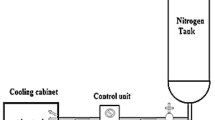Abstract
In this work, an attempt has been made to optimize the process parameters of turning operation for INCOLOY 800H, with the help of cryogenically treated multilayer CVD-coated tool. The influencing factors like cutting speed, feed rate and depth of cut were selected as input machining parameters. The output responses such as surface roughness, microhardness, the degree of work hardening and material removal rate were considered in this work. The experimentation was planned and conducted based on Taguchi \(\hbox {L}_{27}\) orthogonal array with three factors and three levels. Technique for order preference by similarity to ideal solution (TOPSIS) is a multi-criteria decision making tool has been used to optimize the turning parameters. Analysis of Variance is employed to identify the significance of the process parameters on the responses. Tool wear analysis also has been studied. This experimental research had proved that machining performance could be improved efficiently by the support of projected approach.
Similar content being viewed by others
References
Kadirgama, K.; et al.: Optimization of surface roughness in end milling using potential support vector machine. Arab. J. Sci. Eng. 37, 2269–2275 (2012)
Thakur, D.; et al.: Optimization of high speed turning parameters of superalloy Inconel 718 material using Taguchi technique. Indian J. Eng. Mater. Sci. 16, 44–50 (2009)
Zuperl, U.; et al.: Fuzzy control strategy for an adaptive force control in end-milling. J. Mater. Process. Technol. 164–165, 1472–1478 (2005)
Schwach, D.W.; Guo, Y.B.: A fundamental study on the impact of surface integrity by hard turning on rolling contact fatigue. Int. J. Fatigue 28, 1838–1844 (2006)
Jasinevicius, R.G.; et al.: Influence of the mechanical and metallurgical state of an Al–Mg alloy on the surface integrity in ultraprecision machining. J. Braz. Soc. Mech. Sci. Eng. 25(3), 222–228 (2003)
Singh, D.; Venkateswara rao, P.A.: Surface roughness prediction model for hard turning process. Int. J. Adv. Manuf. Technol. 11–12(32), 1115–1124 (2007)
Krolczyk, G.; et al.: Microhardness and surface integrity in turning process of duplex stainless steel (DSS) for different cutting conditions. J. Mater. Eng. Perform. 23, 859–866 (2014)
Dinesh, G.; et al.: Effect of cutting parameters on the degree of work hardening and tool life during high-speed machining of Inconel 718. Int. J. Adv. Manuf. Technol. 59, 483–489 (2012)
Gaitonde, V.N.; et al.: Multiperformance optimization in turning of free-machining steel using Taguchi method and utility concept. J. Mater. Eng. Perform. 18, 231–236 (2009)
Reddy, T.V.S.; et al.: Machinability of C45 steel with deep cryogenic treated tungsten carbide cutting tool inserts. Int. J. Refract. Met. Hard Met. 27, 181–185 (2009)
Akıncıoğlu, S.; et al.: A review of cryogenic treatment on cutting tools. Int. J. Adv. Manuf. Technol. 78, 1609–1627 (2014)
Gadakh, V.S.: Parametric optimization of wire electrical discharge machining using topsis method. Adv. Prod. Eng. Manag. 7(3), 157–164 (2012)
Lan, T.S.: Taguchi optimization of multi-objective CNC machining using TOPSIS. Inf. Technol. J. 8(6), 917–922 (2009)
Srinivasan, L.; et al.: Application of GRA and TOPSIS optimization techniques in GTA welding of 15CDV6 aerospace material. Trans. Indian Inst. Met. https://doi.org/10.1007/s12666-017-1166-y
Akincioğlu, S.; Gökkaya, H.; Uygur, l: A review of cryogenic treatment on cutting tools. Int. J. Adv. Manuf. Technol. 78(9–12), 1609–1627 (2015)
Ross, P.J.: Taguchi Techniques for Quality Engineering. McGraw-Hill Publication, New York (1998)
Selvaraj, D.P.; Chandramohan, P.: Optimization of surface roughness of AISI 304 Austenitic stainless steel in dry turning operation using Taguchi design method. J. Eng. Sci. Technol. 5(3), 293–301 (2010)
Palanisamy, A.; Selvaraj, T.; Sivasankaran, S.: Taguchi-based grey relational analysis for modeling and optimizing machining parameters through dry turning of Incoloy 800H. J. Mech. Sci. Technol. 31(9), 4159–4165 (2017)
Ansari, M.I.; Kotiveerachary, B.: Study of the effect of minimum quantity lubrication on the surface roughness of Incoloy 800 during Turning operation. Int. J. Current Eng. Technol. 2, 18–22 (2014). https://doi.org/10.14741/ijcet/spl.2.2014.04. (Special Issue)
Special metals, www.specialmetals.com
Venkata rao, R.: Machinability evaluation of work materials using a combined multiple attributes decision-making method. Int. J. Adv. Manuf. Technol. 28, 221–227 (2006)
Tripathy, S.; Tripathy, D.K.: Multi-attribute optimization of machining process parameters in powder mixed electro-discharge machining using TOPSIS and grey relational analysis. Eng. Sci. Technol. Int. J. 19, 62–70 (2016)
Kuttolamadom, M.A.; Hamzehlouia, S.; Mears, M.L.: Effect of machining feed on surface roughness in cutting 6061 aluminum. SAE Int. J. Mater. Manuf. 3(1), 108–119 (2010)
Senthil Kumar, A.; et al.: The effect of tool wear on tool life of alumina-based ceramic cutting tools while machining hardened martensitic stainless steel. J. Mater. Process. Technol. 173, 151–156 (2006)
Li, G.; Yi, S.; Sun, S.; Ding, S.: Wear mechanisms and performance of abrasively ground polycrystalline diamond tools of different diamond grains in machining titanium alloy. J. Manuf. Process. 29, 320–331 (2017)
Li, G.; Rahim, M.Z.; Ding, S.; Sun, S.: Performance and wear analysis of polycrystalline diamond (PCD) tools manufactured with different methods in turning titanium alloy Ti-6Al-4V. Int. J. Adv. Manuf. Technol. 85, 825–841 (2016)
Author information
Authors and Affiliations
Corresponding author
Rights and permissions
About this article
Cite this article
Palanisamy, A., Selvaraj, T. & Sivasankaran, S. Optimization of Turning Parameters of Machining Incoloy 800H Superalloy Using Cryogenically Treated Multilayer CVD-Coated Tool. Arab J Sci Eng 43, 4977–4990 (2018). https://doi.org/10.1007/s13369-018-3287-y
Received:
Accepted:
Published:
Issue Date:
DOI: https://doi.org/10.1007/s13369-018-3287-y




